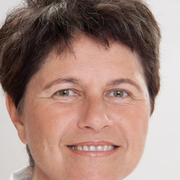
Center for Anatomy and Cell Biology (Division of Anatomy)
Position: Associate Professor
ORCID: 0000-0002-5800-9089
ursula.windberger@meduniwien.ac.at
Keywords
Hemorheology; Hemostasis; Materials Testing; Rheology
Research interests
We love to use animal blood to formulate structure-function relationships (see chapter 12 in: DOI 10.1201 / b21806). We think that the comparative approach is important to prove the validity of universal statements obtained by examining only one species (human). Our interest recently turned to blood plasma. We showed that plasma is viscoelastic under optimized conditions1, is shear-thinning in swine2, and creates a halo around RBCs of several species3, which protects the cell and enlarges its functional diameter. New SANS data on the correlation between albumin molecules, supporting the non-Newtonian behavior of plasma are surprising and motivating.
We assess the rich mechanical response of blood/plasma clots by our LAOStress protocol4, which displays distinctive shear stress thresholds for the start and the completion of fiber alignment in the gel. We can identify amyloidic fibrin networks5 and started to apply the test protocol to other materials, such as collagen hydrogels with or without embedded cells6,7. Currently, we hope to shed light on the interfacial conditions between blood/plasma and a solid substrate, and to learn more about the fibrin clot mechanics that forms at modified interfaces.
Selected References
1 10.1002/jbm.a.37286
2 10.3233/CH-231701
3 10.3390/molecules26092771
4 10.3390/molecules25173890
5 10.3389/fimmu.2020.01551
6 10.1021/acsami.2c20040
7 10.1016/j.mtbio.2022.100262
Techniques, methods & infrastructure
Rheometers (Physica MCR series, Anton Paar, Graz, Austria) for the characterisation of viscoelastic materials. Different shear geometries for gels and liquids, Rheo-Optik. Myrenne aggregometer (Roetgen, Germany) for RBC aggregation.
Grants
- "Turbocomp" - Nano-verstärkete Composites für Turbinenanwendungen (project partner) (2015)
Source of Funding: FFG (Austrian Research Promotion Agency), TAKE OFF
Principal Investigator - "BII_NACO" - Bio-Inspired Ultra Light-Weight Nanocomposite Materials for Application to Large and Gossamer Structures in Space (project partner) (2012)
Source of Funding: FFG (Austrian Research Promotion Agency), ASAP (Austrian Space Applications Programme)
Principal Investigator
Selected publications
- Windberger, U., Baroni, P. and Noirez, L. (2021) ‘Capillary‐size flow of human blood plasma: Revealing hidden elasticity and scale dependence’, Journal of Biomedical Materials Research Part A, 110(2), pp. 298–303. Available at: https://doi.org/10.1002/jbm.a.37286.
- Windberger, U., Sparer, A. and Elsayad, K. (2023) ‘The role of plasma in the yield stress of blood’, Clinical Hemorheology and Microcirculation, 84(4), pp. 369–383. Available at: https://doi.org/10.3233/ch-231701.
- Baier, D. et al. (2021) ‘Red Blood Cell Stiffness and Adhesion Are Species-Specific Properties Strongly Affected by Temperature and Medium Changes in Single Cell Force Spectroscopy’, Molecules, 26(9), p. 2771. Available at: https://doi.org/10.3390/molecules26092771.
- Windberger, U. and Läuger, J. (2020) ‘Blood Clot Phenotyping by Rheometry: Platelets and Fibrinogen Chemistry Affect Stress-Softening and -Stiffening at Large Oscillation Amplitude’, Molecules, 25(17), p. 3890. Available at: https://doi.org/10.3390/molecules25173890.
- Windberger, U. et al. (2019) ‘Near-Newtonian Blood Behavior – Is It Good to Be a Camel?’, Frontiers in Physiology, 10. Available at: https://doi.org/10.3389/fphys.2019.00906.